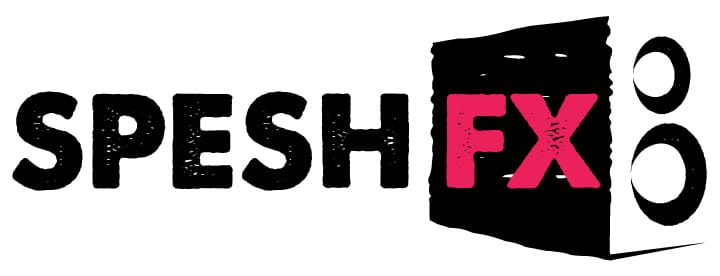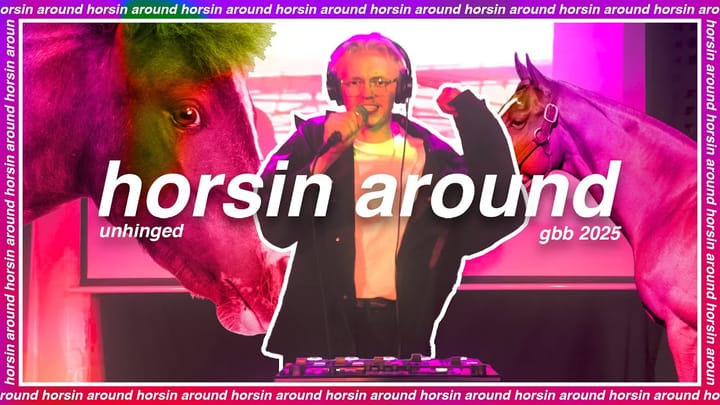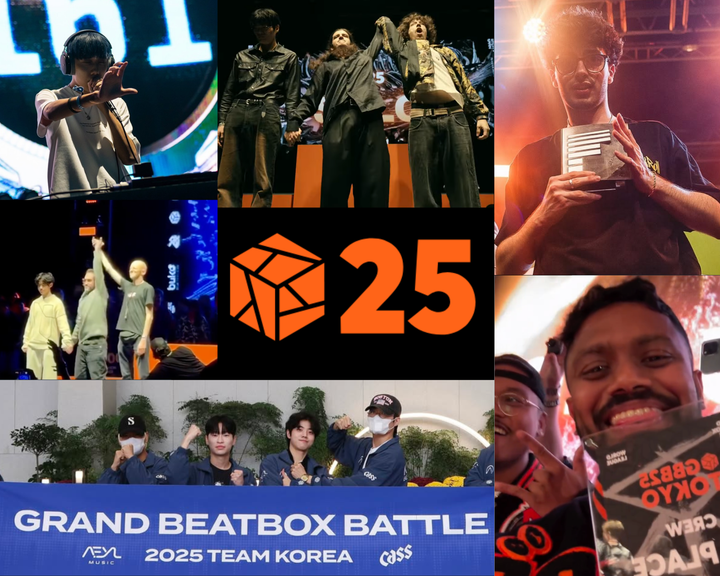Welcome (Back) to SpeshFX
The beatboxing podcast is back, this time as a newsletter.

In one night I saw all the beatbox community had to offer.
It was my first beatbox event, my first time reporting as a journalist. Saturday night of the 2018 American Beatbox Championships. As I walked into Greenpoint’s Brooklyn Bazaar, I heard GBB champions Kenny Urban and NaPoM through the ceiling. Dragged by my ears, I found my way up a staircase to the main hall.
I met Kaila Mullady, two-time world champion and three-time American loop champion, on the stairs. Before I finish introducing myself, she already has me enveloped in a hug, inviting me to the community. We had spoken briefly over email, and that’s all she needed to welcome me like family.
Inside the main hall, the performers melted my face repeatedly. Trung Bao, the 2016 Vice-American Champion, performed his legendary wildcard routine, Venom, Amit showed off a classic rendition of his “Fresh”, and Sung Beats wrecked future world champion BizKit in the loop semi-finals with a never-seen-again cover of “Bodak Yellow.”
I met a married couple from Pittsburg whose three year old daughter spent the entire night seated on the stage monitors. They drove out at their daughter’s insistence, to support a nascent hip hop dancing career.
In the back of the room two OG POC members of the American Beatbox scene proudly proclaimed “wow, there’s a lot of [n-words] in here,” and a ten year old Ultrasonic—a non-binary beatboxer from New Jersey—performed an impromptu showcase.
I’m Tani Levitt. I’m a journalist and podcaster from the USA, and since 2018, I have been writing about beatboxing. My brother introduced me to the international beatbox community back in 2017, and I’ve been hooked since. In my years reporting on the beatbox world, I have come back to these same themes, time and again. The power of the music, the importance of the community organizers, the difference between live and online performances, the youth driving the beatboxing movement, and the acceptance (or not) of people of color, women, and other minorities in the beatbox community. I came for the face melts, and stayed for the compelling stories the beatboxing world was telling in real time.
Back then, I was just beginning my journalism career, and I jumped in headfirst, reporting, hosting, and producing, SpeshFX, a narrative podcast about the international beatboxing community. I interviewed national beatbox champions (hi FootboxG, Reeps One, BreZ), world beatbox champions (Kaila, Alexinho), and some of the biggest community leaders (Kazu, Pepouni, DKoy). The podcast did well—so much so, that at the 2021 Grand Beatbox Battle in Poland, a Malaysian man introduced himself to me as a SpeshFX listener, a very proud moment for me—and upon release, SpeshFX was included on Apple Podcasts’ New and Noteworthy lists for Music, Arts, and Performing Arts. Chances are, many of you are here because you heard an episode or eight. Good to have you back!
In the intervening years, I have migrated my beatboxing coverage from audio to print, writing beatbox stories for Human Beatbox, The Times of Israel, Brooklyn Magazine, and Straus News. This reporting has tracked with my growth as a journalist. First, at the Stony Brook Audio Podcasting Fellowship, where I honed my audio skills and launched SpeshFX, and then at New York University’s Arthur L. Carter School of Journalism, where I just earned a master’s degree in journalism, and worked on my recent written stories.
Now, armed with experience and education, I am off on my own, pursuing important stories in the beatbox world once more. I am relaunching SpeshFX, this time as a newsletter on Substack. The urge is still the same as it was when I started working on SpeshFX. Beatbox is awesome, and that makes it worth writing about.
Here’s what I wrote then in my introduction to Human Beatbox:
“Beatboxing hangs in a unique and exciting moment. The skill level across the world is as high as it has ever been, and the viewership is exploding. Now is the time to hear about beatboxing. To get in on the fun. YOU want to be THAT girl who is able to say, ‘I was into beatboxing before it became huge.’” -- SpeshFX Episode 1
Since I wrote those words, the beatboxing community has undergone myriad changes (and one could argue that you’re too late to be into beatbox before it became huge). The Grand Beatbox Battle left Switzerland, the Beatbox Battle World Championship disappeared (and reappeared), loopers discovered second devices, Boss Dropped the MKII, and for over a year, a worldwide plague forced battles back online from whence they came.
The live online events took on greater importance, and hosting organizations found ways to imbue them with gravitas and meaning. Even now, as live events are back, online events continue to play an important role in determining tastes, discovering talent, and funneling money to artists. A rising tide has buoyed the biggest YouTube channels, and despite the pandemic, beatbox channels have enjoyed steady growth in their subscriber base.
Words like mix, structure, and reaction video entered the lexicon. Beatboxer/producer collaborations finally took off in earnest, as did beatbox music videos. There is an expectation that wildcards, shoutouts, and battles will provide high production value. Audio and video quality must be high, and the producers who can provide those services have become as well known for their edits and mixes as for their music, if not more.
And, of course, the beatbox community’s complete and utter failure to support women, minorities, and the LGBTQIA+ community has only gotten worse. Multiple international stars have been blacklisted for assaulting fellow community members; whispers abound about others who have yet to be called out as publicly. Judging panels for the biggest events are reliably male, white, and western.
In this context, it is as important as ever to put the beatbox community under the microscope. To identify the people innovating, making the community sustainable, safe, and fiscally prosperous, and those who would hold it back, or use it for their own self-aggrandizement. That’s what I’m going to try to do here. At times that will come through Q&As and profiles with key players, other times it will come through reported stories about trends, and often it will come in the form of analysis articles.
In the first two months of this newsletter, I will be sharing a representative sampling of what you can expect to see here. First, a story I’ve been working on for nearly two years: an investigative story about Swissbeatbox and the challenges artists face when trying to make a career of beatboxing. Then, a series of honest assessments of where the beatbox world stands vis a vis money, women and minorities, infrastructure, and music making. Lastly, profiles with two artists whose musical approaches have been impacted by the places in which they live.
My plan for now is to release two or three articles a month. One will always be free, and it will always be one of the opinion/analysis stories. Simply put, those will always be well researched and thought out, but the reported stories take more work from me. If SpeshFX is going to be viable, I’m going to need those to drive subscriptions.
This project is just beginning, and I hope you’ll get involved. If there’s a topic you want to read about, let me know. If something I write is especially awful/amazing, let me know what about it stands out. And if you’re someone in the media world who wants to bring this newsletter to their publication, or to bring back the SpeshFX podcast, I’m all ears 😉
Again, from my introductory HBB post…
What I know, and what you probably know too if you are reading this, is that beatboxing has a story worth telling. YOU have a story worth telling. I’ve been following beatboxing since 2017, and all the while, it has boggled my mind that there isn’t anywhere to read or listen to critical coverage of beatboxing.
The beatboxing community is young and developing, and despite that, it already has a rich culture and really good music to analyze. So I decided to provide the critical coverage I thought was missing.
I’m here. I’m listening. I’m paying attention. And I’ll be here, for good and bad, sharing the most important stories in the beatboxing world. I hope you’ll join me.
— Tani
One More Thing 😉
There are so many amazing beatbox events happening across the world, and because of time, money, and awareness, I won’t be able to cover them all. But I’m going to use this space at the end of my newsletter to account for that in two different ways.
First, I’m going to be collecting short recaps from the amazing beatboxers hosting and competing at these events. My analysis and reporting is top notch (if I do say so myself), but this will be a way for you to hear directly from the people breathing life into the art of beatbox every single day.
Second, I will be listing as many upcoming beatbox events as I can find. So if you have an upcoming event, get in touch! I’d love to include your event here.
So today, for our first on-site report, here is Gale, the 2021 Australian Beatbox Champion. He just co-hosted and judged the Sydney Beatbox Royale at the Oxford Art Factory. Congratulations to all the competitors, especially Brunny, who took home the title!
The event went amazingly. It was at the Oxford Art Factory in Sydney. 1st place went to Brunny from New South Wales, 2nd place to Warlock, 3rd place went to MrC. And 4th place went to Nerish from Japan, which was really awesome. I think it's one of the first times we've had an international competitor at our state competition.
We had performances from BVT, The Tribe, myself, Rex, Codfish, and Lukerativ. Really wholesome event, a lot of respect on stage, a lot of love for beatboxing. Yeah, it was really awesome. Hope you have a great holidays!! – Gale
🥇 Brunny (@BrunnyBBX)
🥈 Warlock (@_Warlock_BBX_)
🥉 MrC (@connormalanos)
4️⃣ Nerish (@nerish_auslife)



